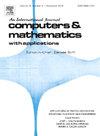Numerical solutions of multidimensional nonlinear hyperbolic partial integro-differential equations using a redefined cubic B-spline-based differential quadrature method
IF 2.5
2区 数学
Q1 MATHEMATICS, APPLIED
引用次数: 0
Abstract
The primary objective of this work is to present an efficient numerical method for solving multidimensional nonlinear hyperbolic partial integro-differential equations (HPIDEs). To implement this method, the following steps are sequentially followed. First, by integrating both sides of the HPIDE, we transform it into a new form of a partial integro-differential equation with a time derivative of first order. This new formulation allows the proposed method to ultimately reduce the problem of finding an approximate solution to a system of linear algebraic equations without employing linearization techniques. Next, for the discretization of the newly obtained form in temporal direction, a combination of the Crank–Nicolson finite difference technique and numerical integration methods, including the trapezoidal and rectangle integration rules, is utilized. This process results in a finite difference scheme with second-order convergence, and its stability and convergence are thoroughly examined using energy method. The Richardson extrapolation technique is also utilized to improve the convergence order in the temporal dimension. Furthermore, a differential quadrature method (DQM) based on a redefined structure of cubic B-splines is employed for the spatial discretization of the problem. Finally, some numerical examples in various dimensions are provided to evaluate the accuracy and effectiveness of the proposed method.
多维非线性双曲型偏积分微分方程的重定义三次b样条微分求积分法数值解
本文的主要目的是提出一种求解多维非线性双曲型偏积分-微分方程的有效数值方法。要实现此方法,需要依次执行以下步骤。首先,通过对HPIDE的两边积分,将其转化为具有一阶时间导数的偏积分微分方程的新形式。这个新的公式允许提出的方法最终减少寻找线性代数方程组的近似解的问题,而不使用线性化技术。然后,结合Crank-Nicolson有限差分技术和数值积分方法,包括梯形积分规则和矩形积分规则,在时间方向上对新得到的形式进行离散化。这一过程得到二阶收敛的有限差分格式,并利用能量法对其稳定性和收敛性进行了充分的检验。Richardson外推技术也被用于提高时间维度的收敛顺序。在此基础上,提出了一种基于三次b样条重定义结构的微分正交法(DQM),对该问题进行了空间离散化处理。最后,给出了不同维度的数值算例,验证了该方法的准确性和有效性。
本文章由计算机程序翻译,如有差异,请以英文原文为准。
求助全文
约1分钟内获得全文
求助全文
来源期刊

Computers & Mathematics with Applications
工程技术-计算机:跨学科应用
CiteScore
5.10
自引率
10.30%
发文量
396
审稿时长
9.9 weeks
期刊介绍:
Computers & Mathematics with Applications provides a medium of exchange for those engaged in fields contributing to building successful simulations for science and engineering using Partial Differential Equations (PDEs).
 求助内容:
求助内容: 应助结果提醒方式:
应助结果提醒方式:


